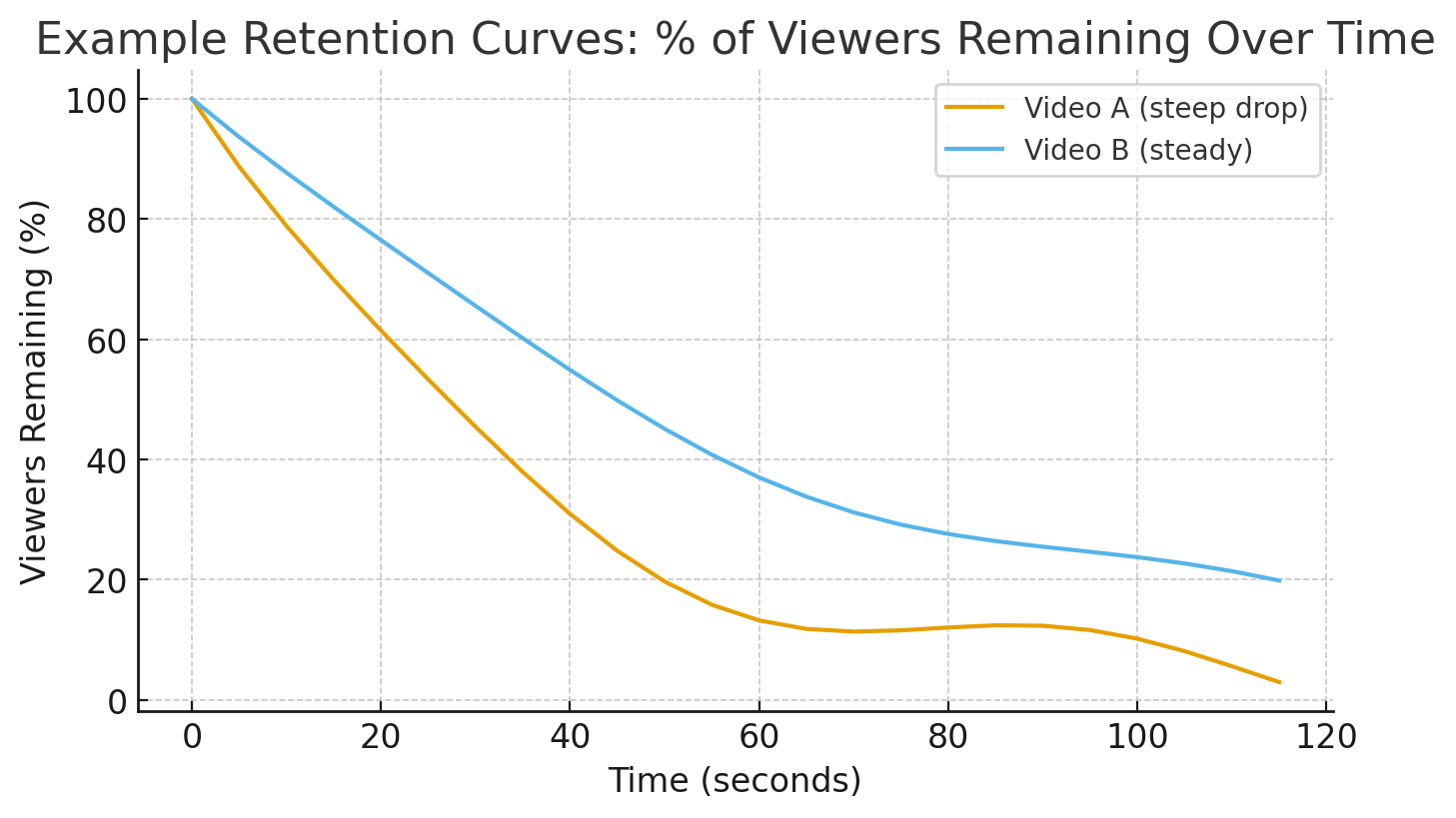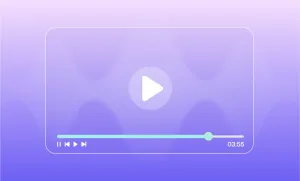The algorithm isn’t judging your thumbnail. It’s watching your viewers: how long they stay, when they drop, and whether they come back for more.
That invisible data is what separates growing channels from stagnant ones. It’s not about how many people click play, but how many keep watching until the end.
Creators who understand that outperform those who only chase views. Because once you know how to increase video engagement, you can predict how your videos will rank and how fast your audience will grow.
In this guide, we’ll teach you just that, breaking down the psychology behind retention, what makes a strong hook video, and how the best creators keep their viewers locked in until the end.
What is video engagement rate?
Video engagement rate measures how much and how long people interact with your video, primarily watch time and audience retention, supported by visible interactions like likes, comments, shares, and replays. Platforms like YouTube explicitly track watch time and average view duration, and surface audience retention charts so you can see where viewers drop off.
Views vs. engagement
A view only says someone clicked play. Engagement shows whether they actually stayed. A video with 10K views but an 80% average watch-through can outperform 100K views with a fast drop-off because watch time and retention are core signals in ranking systems and recommendation loops.
On YouTube, engagement metrics include interactions (likes/comments/shares) alongside the time people spend watching; Meta reports average watch time for Reels; TikTok exposes retention curves and completion rates, all reinforcing that “how long they watch” matters more than “how many started.”
How to read the metric
Think of video engagement rate as a practical umbrella KPI you compute from the video engagement metrics each platform provides:
• Watch time & average view duration → strongest indicators of audience engagement (people stayed).
• Retention curve / key moments for audience retention → where attention drops or spikes.
• Interaction rate (likes, comments, shares, saves) → active signals that complement time watched.
Rule of thumb. If you must choose one family of metrics to prioritize, pick video retention rate and watch-time-based indicators first; then use interactions as supporting proof that the content resonated. That’s how modern systems evaluate whether to push your video further.
Retention curve comparison
The chart below shows two videos with the same topic. Video A spikes early then loses viewers quickly; Video B holds attention with steadier pacing. Even with fewer initial views, Video B is more likely to be recommended because it sustains viewing longer, improving overall watch time and video engagement rate. (Your platform analytics will show a similar retention chart).

Tip: When you review your next upload, start with the retention curve: identify the first big drop, tighten everything before it, and test a stronger opening to increase video engagement on the next iteration.
Why engagement matters more than views
The algorithm rewards creators who keep people watching. On every major platform, time watched and retention outweigh raw view count when it comes to distribution.
• YouTube. YouTube’s search & discovery systems aim to surface videos people are most likely to watch and be satisfied with. That’s why watch time, average view duration, and audience retention are central; YouTube even gives you “Key moments for audience retention” to spot drop-offs and improve pacing. Creators who increase video engagement via higher retention earn more impressions in browse/recommended surfaces.
• TikTok. TikTok’s For You feed ranks videos using interaction signals and completion behavior, whether people watch to the end, rewatch, share, or follow, so videos that hold attention get expanded distribution beyond the initial test group.
• Instagram Reels. Instagram highlights watch time alongside likes and sends as top ranking signals; Reels insights expose watch time and replays, reinforcing that sustained viewing drives reach more than taps alone.
Views open the door, engagement decides if you stay in the room. A video with fewer starts but a stronger YouTube engagement rate (longer average view duration, steadier retention) will typically be favored over a high-view video with early drop-offs, because it keeps viewers on the platform longer and signals satisfaction.
Pro tip: When evaluating performance, rank your videos by watch time per impression and retention at key timestamps (e.g., 3s, 30s, 50%) before you look at total views. This aligns your editing decisions with how recommendation systems actually promote content.
Understanding video engagement metrics
If you want to know what’s really working in your videos, start with the numbers that matter most. These video engagement metrics show where your viewers stay, where they drop, and what makes them come back.
Average view duration
This metric shows how long, on average, viewers stick around. A longer average view duration signals stronger audience retention and a higher chance your video will be recommended to new viewers. For creators focused on growth or brand awareness, this is one of the most valuable indicators of content quality.
Retention curve
Every platform visualizes attention decay differently, but the shape tells the same story: where people drop off, skip, or rewatch. Smooth curves indicate steady pacing, while sudden drops usually mean your hook didn’t land or a segment dragged on too long. Tracking and improving this curve is one of the most practical video retention rate tips for sustaining attention.
Watch-through percentage
Sometimes labeled as “average percentage viewed,” this metric compares how much of your video was watched relative to its total length. A video with 80% completion consistently outperforms one with 30%, even if the latter gets more clicks.
Interaction rate
Likes, comments, shares, saves: these are visible signs of audience connection. While they don’t always guarantee reach, they strengthen overall performance when combined with high watch time, signaling that your content resonates enough for viewers to take action.
For awareness-focused creators, prioritize watch time, view duration, and retention. For conversion-driven campaigns, track interaction rate and replay behavior.
The smartest strategy blends both, using these video engagement metrics to understand not just how many people watched, but how much your content truly mattered to them.
What is a video hook (and why it matters)?
What is a video hook?
A video hook is the moment that decides whether someone keeps watching or scrolls away. It’s the first few seconds where you earn attention, or lose it.
Psychologically, hooks work because of attention bias and dopamine anticipation. The human brain constantly looks for novelty and reward. When a video introduces something unexpected, a bold statement, a visual contrast, or a question, it activates the brain’s prediction system. Viewers instinctively stay to see if that promise is fulfilled.
This is why great creators obsess over the opening three seconds more than the next three minutes.
For many, mastering this moment is part art, part data. Some rely on testing frameworks or even a video hook generator to craft openers that stop the scroll and spark emotion. But the best hooks should still feel human, authentic, and contextually relevant to the story that follows.
Types of hooks that work
Visual hooks. Fast cuts, striking contrast, or unusual framing instantly create visual tension. Think of MrBeast’s chaotic openers or TikToks that start mid-action.
Verbal hooks. A line that creates an open loop, like “I made a huge mistake…,” sets up a story that demands closure.
Situational hooks. Drop the viewer into a moment of conflict, urgency, or transformation. Start at the climax, not the setup.
Real-world examples
• On YouTube, Casey Neistat often opens with a visual payoff first, then explains it, keeping curiosity alive.
• On TikTok, creators use split-second humor or mystery (“Wait for it…” or “You won’t believe what happened next”) to ride the dopamine wave.
When you learn how to design the hook intentionally, every other part of your video performs better.
How to increase video engagement
Here are the most effective ways to increase video engagement, boost retention, and keep viewers hooked through every frame.
Start with a strong hook (the first 3 seconds rule)
The average attention span online is shorter than a goldfish’s, and viewers decide whether to stay or scroll within three seconds. The opening of your video is your best chance to stop that scroll.
Your hook should make one promise: Why should I keep watching?
That could be a bold statement, a surprising visual, or an immediate conflict. For example, “I spent $100 testing viral TikTok product: “here’s what actually worked” delivers intrigue, stakes, and outcome in a single line.
If you struggle to brainstorm openers, experiment with a video hook generator or test multiple intro variations to see which version holds attention longest in retention graphs.
The key is to enter fast: no slow fades, no lengthy intros, and make your viewer feel they’ve already missed something if they scroll away.
Pace your edits (cut faster than you think)
Once you’ve earned attention, pacing decides if you keep it. A slow rhythm kills engagement faster than poor lighting ever could.
Modern audiences are used to dynamic storytelling: short beats, purposeful pauses, and constant visual change.
Here’s how to adjust pacing to boost engagement:
• Cut faster than you think. Every moment that doesn’t add value subtracts attention. Trim silences, filler words, and redundant transitions.
• Alternate wide and close shots. Variations keep the viewer’s visual interest alive.
• Use motion to guide focus. Subtle camera moves, zooms, or on-screen text draw the eye exactly where it should be.
Think of your edit like a heartbeat: it should pulse with energy but never feel chaotic. The goal isn’t speed; it’s rhythm that sustains focus.
Build a narrative arc (setup → payoff → reward)
Even short-form videos perform better when they follow a story arc. Humans are wired for narrative: we stay for structure, not length.
To increase video engagement, build around a three-part flow:
• Set up: Establish a question or tension immediately. “Can I fix this problem in 60 seconds?”
• Payoff: Show the process or reveal the result step by step, keeping curiosity alive.
•. Reward: End with closure, surprise, or transformation. Leave the viewer with either satisfaction or a hook for your next video.
This formula works across platforms, from YouTube tutorials to TikTok skits, because it mirrors how our brains crave resolution. A complete story keeps audiences emotionally invested, not just entertained.
Use visual repetition & text highlights
Attention drops when the viewer’s brain has to work too hard to follow. Visual repetition anchors understanding, making key ideas easier to absorb.
Reinforce main points with consistent patterns: color accents, motion templates, or typography that repeats at moments of emphasis.
Text highlights help retention because they engage two senses at once. When you show and say something simultaneously, recall and comprehension rise. It’s a simple but proven audience engagement strategy for both educational and entertainment content.
Pro tip: animate on-screen text in sync with voice cues or beats. This rhythmic alignment makes your content feel more intentional and keeps eyes glued longer.
Leverage captions, emojis, and music for retention
Sound isn’t guaranteed, especially on mobile feeds, so captions are essential. They don’t just make videos accessible; they hold silent scrollers in place.
Captions also boost understanding in fast-paced clips, helping viewers follow along without replaying sections.
Use emojis and music strategically to shape emotion.
• Emojis act as micro visual cues that create warmth or humor.
• Music drives pacing and emotional continuity: sync cuts to beats to maintain energy.
• Silence can be powerful too; use it to reset attention before a key reveal.
These sensory cues keep the experience active and layered: each element pulling a different part of the brain into engagement mode.
Ask for engagement naturally
Direct calls to action often feel forced, but subtle “comment hooks” work brilliantly when tied to curiosity or emotion. Instead of “Like and subscribe,” try “Would you have done the same?” or “Which version did you prefer?”
The goal is to make interaction part of the conversation, not an obligation.
You can also embed “curiosity loops”: pose a question early, deliver half the answer mid-video, and close it at the end. This technique increases average view duration and gives viewers a reason to comment or rewatch.
Other natural audience engagement strategies include:
• Using polls or split-screen reactions.
• Ending with a preview of your next topic.
• Featuring user-generated comments in future videos (creates feedback loops that boost engagement organically).
Optimize feedback loops
Once your video is live, study how people actually watch it. Use the video engagement metrics inside your platform dashboard, retention graphs, replays, completion rates, to spot where attention rises or falls. Then, apply those learnings to your next video.
Creators who continuously iterate based on video retention rate tips, for instance, trimming repeated segments or testing shorter intros, see compounding results over time. Small, data-informed adjustments can transform a decent video into one the algorithm can’t ignore.
How algorithms reward engagement
Every platform runs on the same simple loop: when people watch longer, your video gets shown to more people.
That cycle—retention → more impressions → more watch time → higher ranking—is what keeps creators growing steadily while others fade out.
YouTube Analytics, TikTok Audience Retention, and Reels Insights all measure this with slightly different video engagement metrics, but the principle is identical: sustained attention signals satisfaction.
A video with a higher YouTube engagement rate doesn’t just perform better: it teaches the algorithm your content keeps viewers happy, which earns it another round of exposure.
The exciting part? AI is starting to handle this optimization automatically, analyzing retention patterns, testing new hooks, and even predicting drop-offs before they happen.
The tools are getting smarter, and soon, increasing engagement won’t just be a manual job, it’ll be a partnership between creators and intelligent editing systems built to keep audiences watching.
FAQs
What is video engagement rate?
Video engagement rate measures how much and how long viewers interact with your video, including watch time, likes, comments, and shares. It’s a key indicator of how well your content resonates with your audience and whether it keeps them coming back for more.
How can I increase video engagement fast?
To increase video engagement quickly, focus on strong hooks within the first few seconds, pace your edits for maximum flow, and structure your video with a clear narrative arc. Engaging visuals, captions, and interactive calls to action also encourage more audience interaction and retention.
What is a video hook and why is it important?
A video hook is the first few seconds of your video designed to grab attention and spark curiosity. It’s critical because it determines whether viewers will stay or scroll away. A great hook creates an immediate promise, pulling viewers in and setting the stage for the rest of the video.








